How to breed?
PC-Babylon can be grown even from a single small leaf. Of course, this is a rather complicated and lengthy process. However, the grower will get excellent results with a little effort.
The basic principles are available even for beginners:
- Saintpaulia should be grown in a shallow pot of small volume;
- instead of ready-made store-bought soil, you can take a mixture of 4 parts of turf, 1 part of peat and 1 part of sand;
- direct sunlight is categorically unacceptable;
- you can not grow violets in conditions of high humidity;
- the slightest draft can lead to plant disease;
- excessive addition of fertilizers leads to the loss of decorative properties.
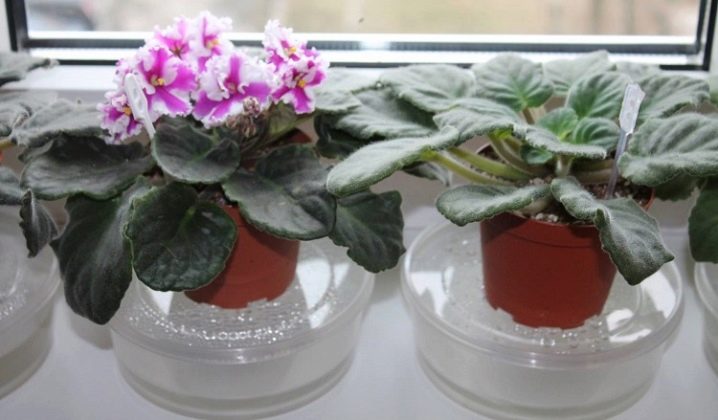
Possible problems in growing violets RS-Duchess
Violets, like other houseplants, sometimes get sick. Each problem has its own solution, the main thing is to establish the exact cause.
Leaf problems
These violets also suffer from fungal diseases. With excessive moisture, the blow falls primarily on the roots and leaves. If this happens, the first step is to apply a fungicide. In addition to the fungus, plants are susceptible to powdery mildew, as well as gray rot or fusarium. This can happen due to low temperatures, moisture on foliage, or drafts.
Pests
The mite is the most dangerous pest for violets. You can find it by drooping and withering leaves. In this case, it is almost impossible to cure the plants. There is only one way: spray with a special anti-tick agent.
In addition, the violet can become infected with worms or aphids. During the flowering period, there is a risk of damage by root gall nematode. This disease is accompanied by growths on the roots - galls, in which the development and reproduction of worms takes place.
Important! In this case, you need to immediately get rid of both the plant and the substrate and disinfect the pot.
Diseases
A violet, like any plant, can easily get sick from another flower nearby. You can bring the disease with dirty hands if you touch violet leaves with them. Pets, too, often carry many diseases on their fur. Most often, the plant is sick in May and September.
Due to dampness, low temperature or stagnant water in the pot, brown or gray spots may appear on the leaves or flowers - fungus. Signs of a fungal infection can be a moldy smell on the flower or the softness of the shoot itself. If they are found, you should immediately remove the damaged areas, then start replacing the soil, and before transplanting, treat everything with a fungicide.
Signs of improper care
One of the signs of improper care is the appearance of gray rot when water gets on the leaves. The affected leaves must be removed. If you water the plant with cold water, there is a risk of brown spots. In case of physical injury, a sharp drop in temperature, a draft or dry air, the leaves dry out. The same problem can be encountered if you overdo it with fertilizers or if there is not enough light.
Thus, like any violet, the RS-Duchess requires careful care and attention. When handled correctly, it will delight with bright colors and exquisite beauty of the leaves. The Duchess is suitable for experienced florists, but beginners are not recommended to start her.
Peculiarities
Before giving a description of the variety, it is worth pointing out that the plants, in common use called violets, in fact, are not them. The Uzambara violet has a completely different scientific name - saintpaulia. It has nothing to do with the flower mentioned in ancient Greek mythology. However, in the future, we will follow the established tradition of using words, meaning by violets it is saintpaulia.
There are a great many varieties of this plant, created by breeders. RS Babylon is one of them. It is easy to see that the plant is covered with flowers of impressive size. They can be up to 8 cm in diameter. The variety is one of the semi-double-flowered violets with a contrasting appearance. The elongated petals contain cherry-colored patches in various places.
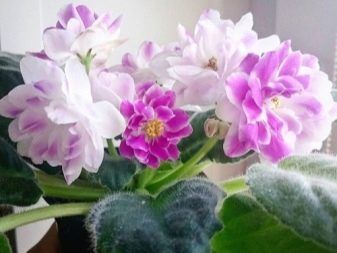
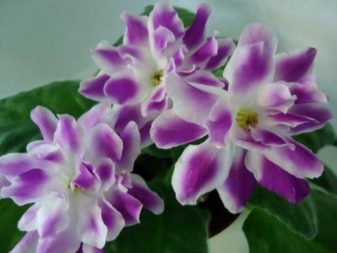
The Babylon rosette includes moderate green foliage. The size of the plant allows it to be classified as a standard group. When the second bloom begins, its splendor increases significantly. There are many small villi on the leathery leaves. The rosette reaches a fairly large size. Young foliage is slightly tucked at the edges. In the course of development, she straightens. In adult flowers, the leaves resemble an oval.
A photograph of a plant of this variety can mislead inexperienced growers. You might think that the variety blooms profusely. In fact, the number of emerging flowers is relatively small. This disadvantage is largely compensated for by the strength and short length of the peduncles.
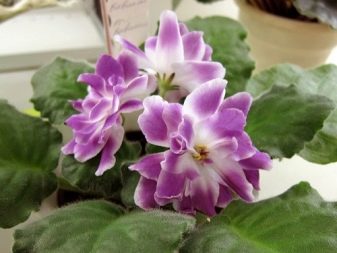

Varieties
Today, many varieties have been bred, which differ in color, degree of terry, and duration of flowering. The most common varieties:
- Simple:
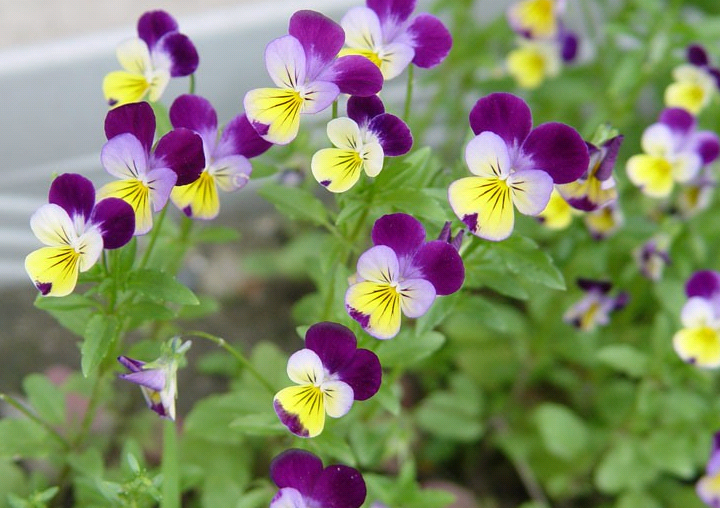
- Bambini - yellow flowers with a purple transition and brown stripes from the center of the petals;
- Firnengold - Lemon petals with a black eye;
- Maxim Marina - the transition of colors from the center to the edges: yellow, dark purple, white, purple;
- Tangenne - white petals with a black eye;
- Universal Series - White petals with a yellow center and purple eyelashes.
- Semi-double:
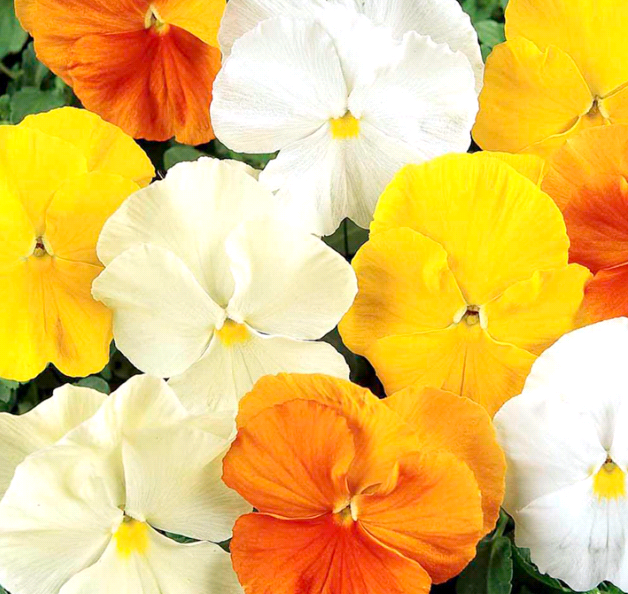
- Alpensee - deep purple flowers with a yellow center
- Delta Pure Deep Orange - peach petals;
- Pure White - white petals with a yellow center
- Adonis - blue petals with a transition to white, yellow center;
- Joker - orange-purple color with a black "eye".
- Terry:
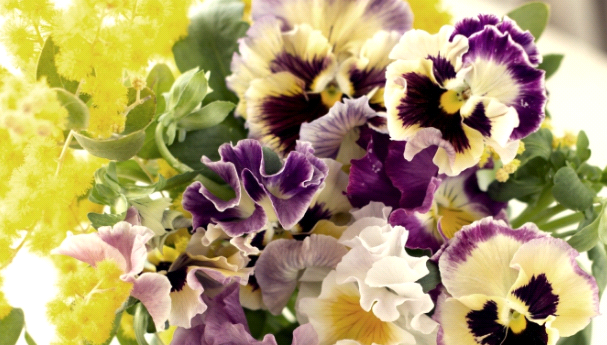
- Cristal Bowl White - white flowers with a yellow center;
- Rococo - purple petals with white edging and a yellow center;
- Shalon Supreme - white-lilac color with a yellow earring;
- Terry lace is a mixture of blue, yellow and purple.
In flower beds, both monochromatic Vittrock violets and multi-colored ones look good. You can plant a number of varieties of the same type, or you can combine different ones. The main thing is to choose them according to the height and size of the flowers so that the composition looks holistic.
How to care for an uzambara violet
With proper care, the violet will delight you with its flowering all year round. And for this all you need to create an optimal temperature regime for it, get rid of drafts and direct sunlight, regularly feed and water. And of course, do not forget to transplant and prune in time.
But not everything is as simple as it might seem at first glance.
Violets should be kept at a temperature of 20-24 ° C and a humidity of 40-60%. The plant needs light from 12 to 14 hours a day, but does not tolerate direct sunlight. Therefore, in the summer, shade it on the north or east windows, and in the winter - on the south or west. Additional lighting in the autumn-winter period will not prevent him.
Thin dark green leaves and elongated stems indicate that the violet lacks light. Light green burnt leaves indicate that there is too much of it.
Be especially responsible for watering: do not allow the soil to dry out, but also avoid waterlogging. Water the plant with warm, settled water so that it does not fall on the leaves.
And although violets love high humidity, they cannot be sprayed from a spray bottle. Therefore, use a special preparation or lower the pot in a tray with wet rubble or pebbles. By the way, it is better to water the plant through the pallet.
To make the violet bloom profusely, feed it every two weeks with complex mineral fertilizers.
Pruning the leaves also has a beneficial effect on the lush blooming of the violet.
Saintpaulias reproduce by seeds, stepchildren, children, but most easily - by leafy cuttings.
Everyone will be able to choose a flower to their liking from a huge variety of varieties of the uzambar violet, and perhaps more than one. After all, they bring not only aesthetic pleasure, but also benefits for health and well-being: the delicate aroma of violets stabilizes heart rhythms and has a beneficial effect on the human condition.
{SOURCE}
Description
These are compact plants with a height of 15-40 cm. Leaves are oval-shaped, dark green in color. Flowers can be 5-10 cm in diameter. They have five petals, three of which form a characteristic "eye".

Coloring can be varied, with complex color transitions. The simplest option is a yellow center surrounded by a black spot with white, yellow, red and blue petals.
There are simple and double varieties. They bloom all summer until mid-autumn. Usually grown as biennial plants. After flowering, they form seed pods, which are sown independently. In this way, you can ensure the continuous growth of pansies in the garden.
Reproduction
Vittrock violets, like horned violets, can be propagated in three ways: by seed, dividing the bush and cuttings. The method of growing through seedlings is considered the most reliable. Planting methods:
- Seeds. They can be planted in February for early flowering or in July for next year's flowering.
For planting in February, garden soil is mixed with peat, humus and sand. Seeds are planted shallow, lightly sprinkled with earth. The boxes are covered with glass or foil. Ventilate them periodically. The ideal temperature for germination is 20 degrees.
After the emergence of seedlings, the seedlings dive into separate pots.

In late May - early June, they are planted in the ground. Ripe seeds can be harvested already in July.
In summer, seeds can be planted in a flower bed, watered and wait for shoots to appear. After that, they should be seated in a permanent place. For the winter, they need to be covered with foliage or spruce branches. In warm climates, the plant will bloom next spring.
- Cuttings. In this way, valuable varieties are bred, and old bushes are also rejuvenated. Cuttings can be cut in May-July, even flowering plants are suitable for this. Apical shoots 5-6 cm long are cut from them, on which 2 nodes have formed.
They are planted in a prepared bed. Plant tightly, 5 cm between shoots. For them to take root well, cover them with a damp cloth. The root system develops in about 3-4 weeks.
By dividing the bush. For this, adult bushes are suitable, at the age of 3-4 years. The plant is dug up, divided into several parts with a sharp knife and sprinkled with ash on the cut. Parts are immediately planted in the beds.
It is important not to divide into too small bushes, otherwise the plant will wither.
Origin
RS-Babylon was bred in Lugansk by the rather famous breeder Svetlana Repkina. It is well known by both amateur flower growers and specialists in various countries. The letters PC just denote authorship. S. Repkina herself recognizes this variety as one of the best results of her activities. Others agree with her on this.
Violets bred by Repkina look equally good on the windowsill and on the rack. For their high decorative qualities, landscape designers highly appreciate them. In cool weather, RS-Babylon blooms as brightly as possible
However, breeders of this culture should be patient and attentive to the flower.
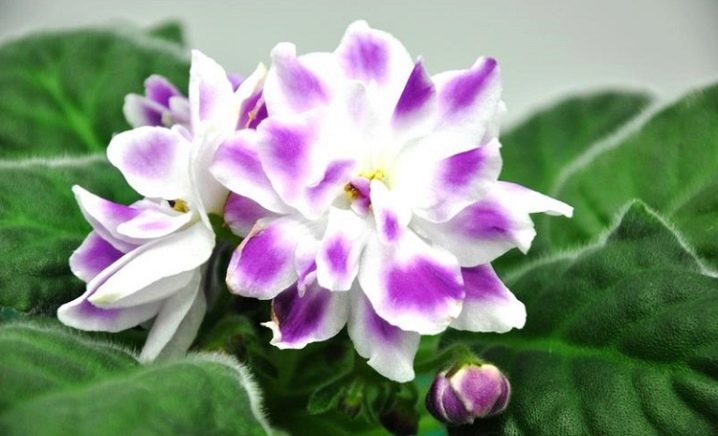
Care
Violet Wittrock loves lit places, but also tolerates shade well. It is often planted under trees to fill empty spaces. It is best to shade it at midday.
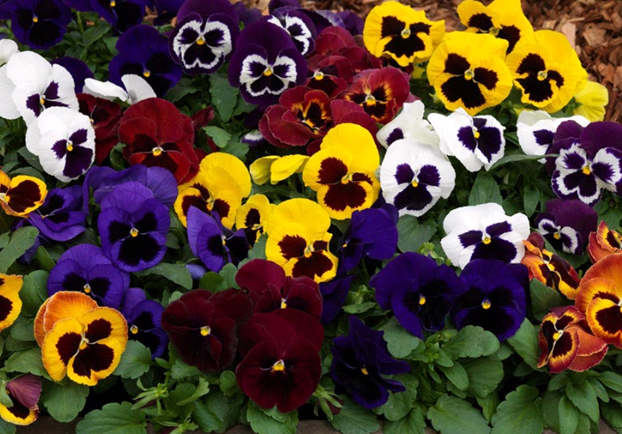
Watering should be done regularly, but infrequently.
This is especially important on dry days so that the pansies don't stop blooming. After watering, loosen the soil and remove weeds.
An important point. Violet Wittrock loves mineral fertilizers.But remember that you cannot feed it with organic fertilizers, especially fresh manure.
This is the whole care of this plant. It is quite simple, so the Wittrock violet is often chosen by novice gardeners or designers of city flower beds.
Large ruffy violet water with photo
Description
Violet subspecies Water is distinguished by large flowers and a ruffled border. Here are the main characteristics of this species:
- Large inflorescences;
- Double flowers;
- Bright, blue and purple color, with lighter frills;
- Pink ends at the petals;
- Border - ruffled, green;
- Dark leaves with wavy edges;
- Red spots are sometimes found on the white back;
- Light petioles.
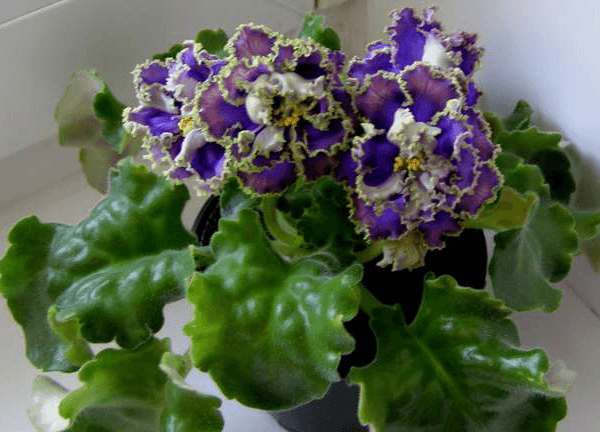
Terry violet of the Vodyanoy variety is very suitable in any collection, as it is compatible with other varieties both in care and in appearance (color scheme). It looks elegant and very original, due to the unusual color transition on the petals. The rosettes are very large, so the owners should be ready for this - so that the inflorescences do not disintegrate. Temperature and light conditions, as well as watering, are very important for this.
Flowers reach six centimeters in diameter, due to which the Vodyanoy violet is especially popular. The frills (ruffles) are green, very wavy, practically creating a kind of spiral. For lovers of ruffles, this subspecies is just right.
Peculiarities
Violet subspecies Water (Dadoyan) has its own characteristics. Even at high temperatures, this indoor “window sill friend” feels good and retains its abundant green ruffle. Parts of the bouquet become like balls, the dark blue color on which smoothly turns into pink with rays and edges.
A special feature is that in the Aquatic species, the buds open for a long time. Flowering lasts about one month, and in the cool - a little longer. One peduncle has up to five pieces in a bouquet. Like any other terry violet, this subspecies blooms perfectly somewhere from the third time (in full beauty, volume and brightness). The frequency depends on the lighting - the more there is, the more often this plant blooms.

A violet of this type has a medium-sized rosette that is not large. The leaves have a red underside, their edges are wavy, graceful. The leaves darken gradually (both on the reverse side and on top), and do not acquire the final color immediately - a young violet may have a light color of leaves and spots on their wrong side (or even a light silver lower part).
Babies from the rooted cuttings appear quite quickly. This takes an average of two months. Children - from three to five pieces.
Video "How to grow violets"
On the record, the famous florist Natalya Chistyakova talks about the main nuances of growing Saintpaulias at home.


